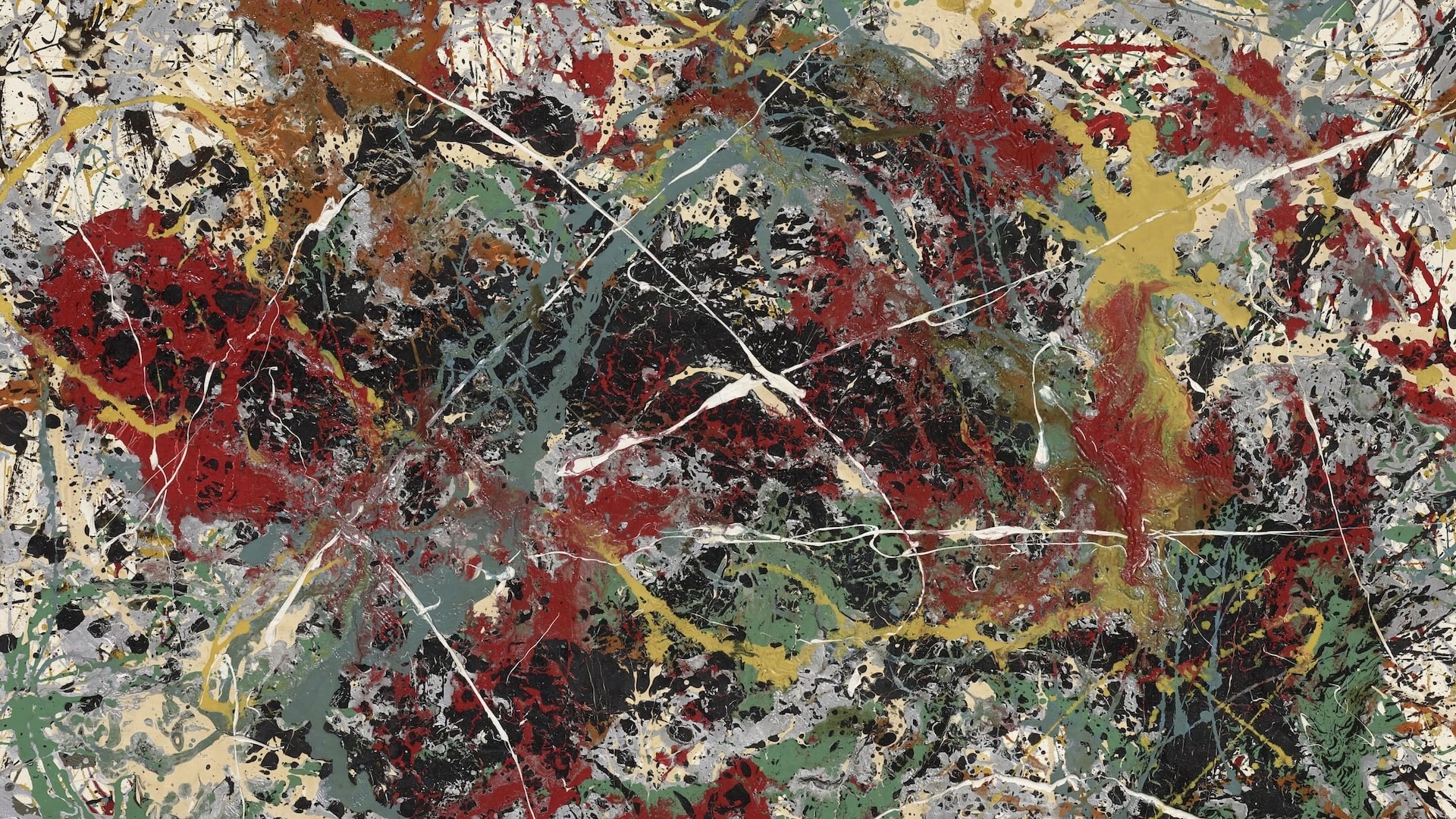“It took me four years to paint like Raphael,” said Pablo Picasso. “But a lifetime to paint like a child.”
New York artist Jackson Pollock might’ve drawn inspiration from Picasso during his early career, but what he probably didn’t anticipate was his own work inspiring casual art admirers to paraphrase Picasso with the age-old critique: “My kid could have painted that.”
The accusation has been levelled towards plenty of artistic movements over the last 70 years, none more than Abstract Expressionism – the first genre of art that caused eyebrows to raise in scepticism instead of awe.
Born in the aftermath of the Second World War, it produced the kinds of paintings that seem like someone tripped and fell onto a canvas with a bucket of brushes, and is today described as giving “the impression of spontaneity.”
But what if I told you the reason for Abstract Expressionism’s rise to prominence wasn’t its ability to provoke emotion or complex ideas?
The art movement was actually catapulted into the spotlight by the Central Intelligence Agency (CIA).

RELATED: What Da Vinci’s Lost Masterpiece Tells Us About The Art Market’s Underbelly
It might sound like a conspiracy theory cooked up by folks who prefer their art from IKEA, but that’s precisely what happened. And to understand why the CIA decided it was a good idea to essentially bankroll the careers of NYC radicals, it’s important to understand what was happening in the late 1940s.
The Allies had just won the war, the United States of America was beginning to settle into its newfound role as the world’s most powerful nation, and Russia wasn’t playing as nicely as it had been a few years prior. In fact, the Cold War kicked off almost as soon as the Second World War ended, giving the US a new enemy they couldn’t defeat with the last set of tactics.
Thus, the CIA was formally established as a successor to the wartime Office of Strategic Services (OSS) in direct response to these growing tensions; and one of its maiden efforts pursued under the agency’s freshly inked mission statement was a propaganda war against the Soviet Union.
Political tensions had been mounting since the surrender of Nazi Germany, though it was a series of Soviet-sponsored conferences that spurned the CIA into action (according to the CIA itself).
In 1949, a conference of around 800 respected intellectuals in New York City called for peace with Stalin, which was interpreted by the State Department as a pro-Communist event. Now the CIA wasn’t going to let that sort of thing go down without a response, and as soon as it ended, senior agency figures plotted their next move.

The solution they devised? Operation Long Leash.
Disappearing into the shadows, the CIA would look to maintain a plausible distance while directing both finance and influence. Covert funding of anti-communist efforts began less than a year after the conference with the founding of the Congress for Cultural Freedom (CCF) – which was established to pump CIA dollars into various magazines, cultural world tours, and yes, competing conferences.
From the outside, the CCF appeared like an organisation set up to promote American artistic endeavours and the values that came with them. In reality, it was the CIA’s dedicated platform to shape ideas and opinions at an arm’s length.
“Give me a hundred million dollars and a thousand dedicated people, and I will guarantee to generate such a wave of democratic unrest among the masses – yes, even among the soldiers of Stalin’s own empire – that all his problems for a long period of time to come will be internal. I can find the people,” said Sidney Hook, American philosopher and Congress for Cultural Freedom founder – a quote that’s proudly displayed by the folks at Langley, Virginia.
At the height of its powers, the CCF conducted operations through offices in 35 countries globally, ran more than 20 different publications, and sponsored prizes for American artists and musicians (Louis Armstrong, Dizzy Gillespie, and Nina Simone were deployed to stage a coup in the Congo).
Through this sprawling network of influence, the CIA decided Abstract Expressionism was the perfect American vehicle to champion across the world. Not only did the CCF pony up for touring exhibitions of Abstract Expressionists, but also used its empire of international publications to celebrate the art movement through bought-and-paid-for critics.


Abstract Expressionism was the focus of the Congress for Cultural Freedom for two significant reasons.
Firstly, its artistic style was so chaotic and so visibly energetic that it’s very easy to connect the dots between it and the brand of “freedom” the US was promoting. Secondly, Abstract Expressionism stood in stark contrast to the state-mandated artwork of Soviet Realism, which we now (unsurprisingly) associate with a propaganda-style of painting.
If you saw a work of Abstract Expressionism and Soviet Realism hanging on a wall next to each other, the CIA believed it would be easy to answer which piece of art was produced in a freer society.
The CCF wasn’t alone in this push behind Abstract Expressionism, either, with institutions like the Museum of Modern Art (MoMA) in New York among its supporters. Nelson Rockefeller, whose mother co-founded the museum, loved the artistic style that he described as “free enterprise painting.” It’s worth noting that MoMA’s board included CBS Chairman and CIA-collaborator William Paley, OSS officer John Hay Whitney, and the CIA’s first International Organisations Division chief Tom Braden.
“We wanted to unite all the people who were writers, who were musicians, who were artists, to demonstrate that the West and the United States was devoted to freedom of expression and to intellectual achievement,” explained Braden (via The Independent).
“Without any rigid barriers as to what you must write, and what you must say, and what you must do, and what you must paint, which was what was going on in the Soviet Union.

“It was very difficult to get Congress to go along with some of the things we wanted to do – send art abroad, send symphonies abroad, publish magazines abroad. That’s one of the reasons it had to be done covertly. It had to be a secret. In order to encourage openness, we had to be secret.”
Other CIA-backed fronts like the Farfield Foundation also funded America’s cultural war efforts. In 1958, an exhibition called The New American Painting was touring Europe when The Tate put their hand up to host the exhibition in London. The only problem was The Tate didn’t have the money to bring the exhibition over from Europe, so American millionaire Julius Fleischmann (President of the Farfield Foundation) came up with the cash to make it happen.
The power of the Congress for Cultural Freedom snowballed for years, until a detailed 1966 exposé by The New York Times revealed the CIA’s broad influence on international political events. This was followed a year later with a report by Christopher Lasch in The Nation revealed the CIA had almost entirely bankrolled the CCF (reproduced in The New York Times circa 1969).
In response to these reports, the aforementioned CIA chief Tom Braden published a column in The Saturday Evening Post provocatively titled I’m Glad the CIA is ‘Immoral’ – which mounted a defence for the agency’s covert actions against the Soviet Union.
The CCF continued to operate after the fallout of these revelations, this time through an additional layer of deniability with funding from the CIA-linked Ford Foundation. Its ties to the CIA were officially severed in 1966 (according to the CIA).
RELATED: The Empire Steps Back – Western Diplomacy’s Decline In The Trump Era

Today, the CIA’s involvement in supporting Abstract Expressionism through organisations like the Congress for Cultural Freedom is no longer a secret; and has “become commonplace in Anglo-American arts writing,” according to Robert Burstow, Associate Professor of History & Theory of Art at the University of Derby.
Despite this, certain critics like art historian Irving Sandler deny what has been ratified as common knowledge, asserting to the BBC, “There was absolutely no involvement of any government agency.”
Given the extensive evidence on hand, Sandler’s case isn’t a compelling one. Especially when compared to the assertions of another authority on the matter, art historian David Anfam, who spent much of his career studying Abstract Expressionism. Also speaking to the BBC, he justifies the legacy of Abstract Expressionism as “the best thing the institution ever paid for.”
“I’d much rather they spent money on Abstract Expressionism than toppling left-wing dictators.”
It’s a fascinating chapter in the history. Not only due to the fact that it effectively paved the way for the modern art we see in museums and galleries this this day, but also as a showcase of the CIA’s subversive creativity when it came to protecting the United States of America’s hegemony.
So the next time you find yourself standing in front of a Jackson Pollock, look past the chaotic splashes of paint and the urge to wonder, “How do art critics take this s**t seriously?” Because now you know: the CIA made sure we all did.

